|
| Kathmandu - The City | |
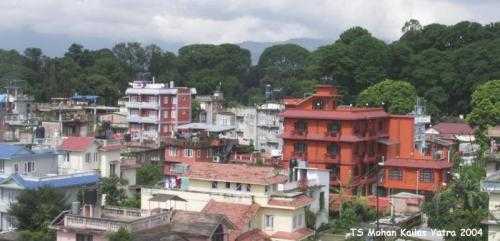
|
|
Most homes and localities in Kathmandu are crowded. Unlike the pristine beautiful country side.
Pick up the free tourist map of Kathmandu at the international airport when you arrive. Pretty useful.
|
| Vegetarian Food while in Kathmandu
 Most if not all Nepalis eat
non-vegetarian food - this is reflected in the existence of very few exclusively vegetarian outlets. A simple
dhal-roti or puri-sabzi or dhal-bhat(rice)-tarkari (vegetables) is the default Nepali cuisine.
Most if not all Nepalis eat
non-vegetarian food - this is reflected in the existence of very few exclusively vegetarian outlets. A simple
dhal-roti or puri-sabzi or dhal-bhat(rice)-tarkari (vegetables) is the default Nepali cuisine.
There are simple vegetarian joints in Thamel near the Thamel Chowk - Shree Lal Vegetarian Restaurant run
by Ritwik Das offers a very reasonable pure vegetarian fare - the husband - wife run show does not offer
any egg based cuisine. Satkar restaurant - a punjabi vegetarian joint is located within the Universal guest house and
offers excellent dhal roti. Hotel Gangjong is a vegetarian haven serving an above average fare.
|
| The Route from Kathmandu to Border Village of Kodari | |
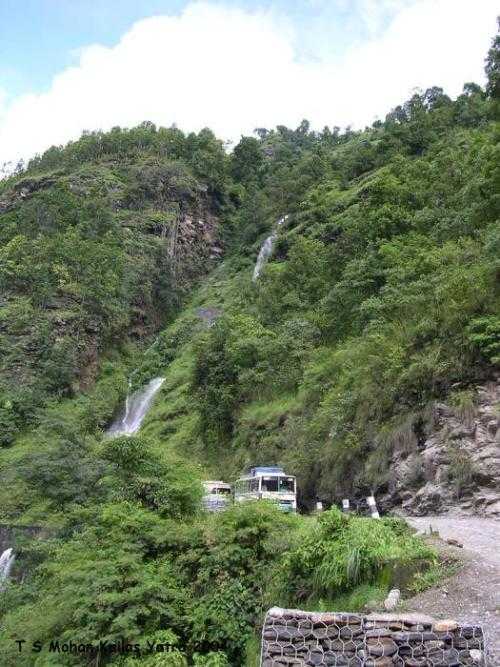
|
|
Buses and trucks have to negotiate waterfalls and streams falling off the mountain side on to the roads.
Many times this leads to landslides and blocked passages in the Monsoon season. Note the wire net wrapped
blocks of stone that hold the roads in position.
|
| Water Falls Galore | |
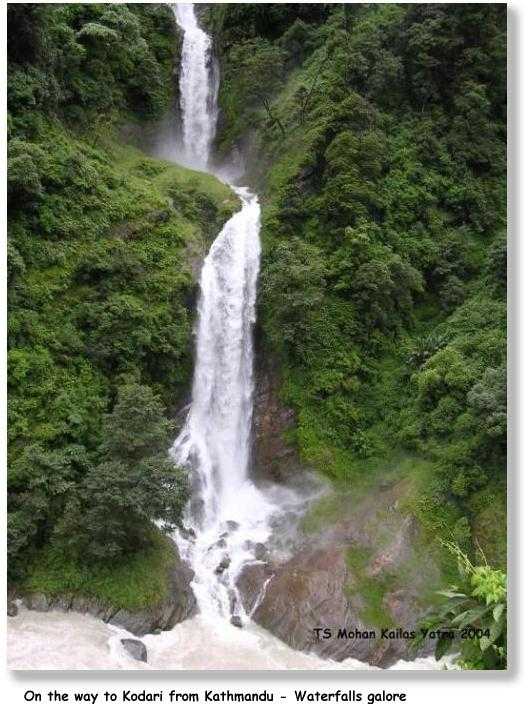
|
|
One of the many big ones lining the way to Kodari. And into the River Bhode Kosi. Beauty just oozes off the Himalayan mountain
with lush green thick vegetation, milky waterfalls and clouds floating by the mountain sides - perhaps
about and below you.
|
Political violence in Nepal - July & August 2004
Nepal has been reeling under a number of student kidnappings, hartals, bombings, bandhs, political assassinations
and disruptions caused by the Leftist groups affliated to Maoist ideology. Be careful to travel in such environment.
The army was out in strength. Our papers and bus was checked several times between Kodari and Kathmandu.
Recommended that you should travel only when this situation subsides and peace prevails robustly.
|
| And the modern man spoils the show | |
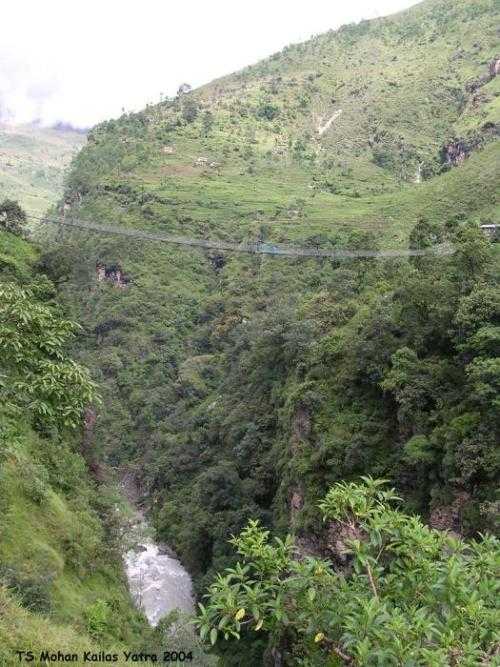
|
|
Bridging the deep gorges cut by the fast moving and powerful 'Bhode Kosi' river has been
vital for the local people to move across and about their lives. Comes the modern man - who erects bungee jumping equipment.
Results - several fatal jumps. Finally it is closed down. Can you see the blue bungee supports on the bridge?
|
| On the Nepal - Tibet Border | |
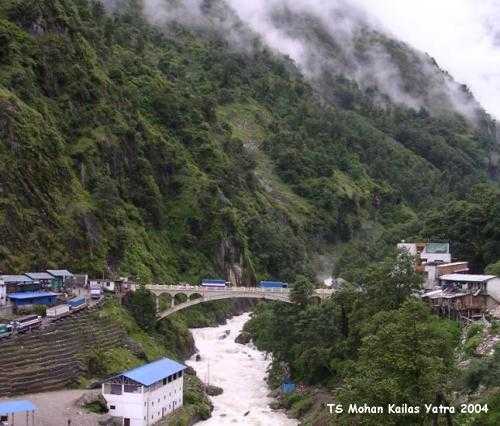
|
|
On the left is Kodari - a narrow village hugging the Himalayas. On the right is China. In between is
the 'Friendship Bridge' over river 'Bhode Kosi' as it gushes down the mountains from Nyalam-mu. Zhang-mu is about 4 kms
from here. .
|
| The town of Zhang-mu | |
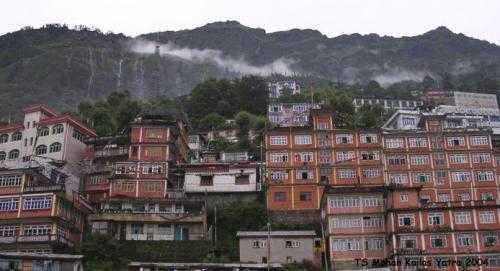
|
|
Lots of colorful buildings along roads which are actually winding up the mountain. Buildings on the mountain
side are at an elevation to the road and just hug it. And look at the multiple waterfalls on the mountain above.
When you are there, squeezed between
these building you can find waterfalls furiously cascading down the mountain.
|
|
|
The Yatra Diary
This yatra description focusses on the route via Kathmandu, Nepal, and was undertaken in the Month of Sravan
- July end, early Aug, 2004.
Taking cue and a lot of help from an earlier yatri, I booked to do the yatra through a travel agency in Kathmandu.
(They did the typical 'Big on talk, low on delivery' act - heard most agencies are no different).
All these travel agencies are sales outfits that also handle the yatra cooking, stay in tents and obtaining chinese
group permits (visas). These agencies hand over the customers to the chinese government run tourist
agencies whose agents / guides handle the entire tour and are truly responsible for your yatra
experience - they hire the transport, handle the drivers, act as interpreters, choose appropriate
way-side inns to stay in case of inclement weather, handle the yak / horse hires at the parikrama etc.
Apart from the (bossy) guides (and their broken english / hindi), others tibetans will not be able to
communicate with you - nor fully understand the sensitivities of a pilgrim. They are doing their job!
If you chance to get incompetent people for this activity, no amount of complaining to your
Nepali travel agency can help. Ofcourse, fortitude helps. Smile bravely, focus and get on with
your pilgrimage goals. That does not mean you have to put up with all the problems - tactfully
handled, you can get to have the chinese guides listen to you and have your needs addressed.
| Temples at Kathmandu
While at Kathmandu, apart from visiting the Pashupathinath temple, one should plan to
visit
Hanuman Dhoka at the old Royal Palace, Kumari Temple residence of the Virgin Goddess,
Taleju Temple an architectural achievement, Bhimsen Temple, Viswanath Temple, and Krishna Temple. In addition,
also visit Swayambunath stupa, Baudhanath Stupa, Chyasin Dega,
Trarik Rimpoches three painstakingly painted chapels,
Jamchen Yiggha Choling,
Nyingma Gompa and
Shechen Tennyi Targye. Plan to have buffer days at Kathmandu before and after the parikrama visit and it will be useful.
 Many of the Hindu temples - especially the management of Lord Pashupathinath temple do not permit photography.
And whatever is obtained is typically a cliched one. Hence I did not take any photos there.
Many of the Hindu temples - especially the management of Lord Pashupathinath temple do not permit photography.
And whatever is obtained is typically a cliched one. Hence I did not take any photos there.
While in Kathmandu, one should also visit the tourist district for precious stones, gems, antique and artware shopping.
Remember to bargain and visit several shops. Rudraksh malas are typically best
in Kathmandu but be careful to buy authentic ones. And definitely not at the offered price but way below it.
|
The negotiation about the journey was done with the Nepali Travel Agency over email over several weeks
and by phone. Payment was done on arrival at the agency office. Many choose to first travel to
Kathmandu and then choose the travel agency after building up the confidence over several
in-person interactions. Until then keep a dialogue on
over the email with several prospects spread over several months.
The fees for the yatra was about USD 1200 or INR 55,000/- from Kathmandu to Kathmandu. Items included in
the costs are: stay (bed and breakfast) for two days at start and one day on return at a good
Kathmandu hotel (no lunch or dinner); transport (bus / truck / land cruiser), stay, permits, chinese
guide, sherpa cook / guide / worker and food costs for the entire journey in Tibet. All travel within Tibet
was by Toyota Land Cruisers - four yatris to a vehicle and overnight stays as much as possible in
tents and sometimes in wayside inns. A truck travels along bringing the camping equipment as
well as the food supplies and sherpas.
Kathmandu is a bustling overcrowded city of peaceloving Nepalis. Most roads are narrow,
dotted with ancient temples in many places. Thamel is the central tourist district with many
souvenir shops; trekking gear outlets; lodges and eating joints. You will also find several
tourist agencies offering competitive tours to Mount Kailash - all these agencies are usually
aggregators - who channel traffic to a few who organize the programmes. Several pointers that
could help you in your negotiations is listed out in appropriate boxed sections.
| Visiting Lord Pashupatinath Temple
While at Kathmandu, do walk down from your hotel to the Lord
Pashupathinath temple. The trek is a prep for the parikrama. The temple is ancient
(7th Century AD) and is dedicated to Lord Shiva. A detailed description can be had from the
brochures and tourist articles in Kathmandu.
 Apart from the
main shrine where south Indian purohits (priests) handle the day long continuous chants
and pujas (done simultaneously and in 'dis-interested' ways), there are other shrines that
reflect the hoary heritage and the tantric background. Non-hindus are not allowed inside
and so are devotees wearing/carrying leather items / photographic equipment. There is a
footwear care center outside the temple complex to handle these needs but depositing costly items
is at potential risk. In addition, one gets
to see old-age homes nearby.
Apart from the
main shrine where south Indian purohits (priests) handle the day long continuous chants
and pujas (done simultaneously and in 'dis-interested' ways), there are other shrines that
reflect the hoary heritage and the tantric background. Non-hindus are not allowed inside
and so are devotees wearing/carrying leather items / photographic equipment. There is a
footwear care center outside the temple complex to handle these needs but depositing costly items
is at potential risk. In addition, one gets
to see old-age homes nearby.
The temple complex is located on
the banks of the river Bhagmati and has a bathing cum crematory ghat. Foreign tourists hang around
the elevated opposite side along the narrow river to get a glimpse of the temple and its heritage.
Lining up along the temple and the river ghat you might find several rooms filled with old
people awaiting their last breath even as their relatives offer emotional comforts.
The monkeys within the temple complex can be brutes - they will grab at any bag that people might carry
and spill open the contents
in search of edibles. Shoo them and you will get the fright of your life when they grab at your dress snarling up.
Ladies attempt shooing and have their sarees pulled at! Give a fruit, they will coyly grab and run! Ofcourse
the local gurkha's stick does some wonders too!
 I had a poignant experience at the temple, past noon, of witnessing something profound and with shades
of modern crudities. The contradictions of the reality unfolding and the philosophic undertones
were overwhelming - here is the scene: Up along the ghat, on the balcony abutting the
temples were devotees lost in devotions of the sublime; on the rooms under this balcony
were the once-in-a-while poignant wails and expressions of difficulties of those in the last lap of their lives; on
the steps from nowhere arrived a cortege with the mourners who then moved the body draped in
white over to a slanting seven feet long slab - touching the river waters on one side and on the other side, up above
several steps, having a big Shiva Lingam at its head.
I had a poignant experience at the temple, past noon, of witnessing something profound and with shades
of modern crudities. The contradictions of the reality unfolding and the philosophic undertones
were overwhelming - here is the scene: Up along the ghat, on the balcony abutting the
temples were devotees lost in devotions of the sublime; on the rooms under this balcony
were the once-in-a-while poignant wails and expressions of difficulties of those in the last lap of their lives; on
the steps from nowhere arrived a cortege with the mourners who then moved the body draped in
white over to a slanting seven feet long slab - touching the river waters on one side and on the other side, up above
several steps, having a big Shiva Lingam at its head.
A female Nepali priest showed up from nowhere
to direct the rituals even as, on the other side of the river bank, the tourists excitedly ran
for prime spots with their canon and sony camcorders and cameras pouting big zoom lenses.
The river and time flowed by non-chalantly. And I got lost into the poignancy and profoundity
of the situation - a scene (with different variations of the profanities) that has been repeating
itself over the centuries and the years and the days. And silently enlightening folks along the way.
 I went into the temple immediately thereafter with my mind swimming in thoughts of philosophic awe.
"O Lord Shiva, You are Lord of the Auspicious (of the blissful devotees in the temple balcony
absorbed inwardly); You are the Lord of the Pashus (of the emotions channelled through tantric
prayers to Lord Kalabhairava - in one of the shrines abutting the balcony in the temple complex);
You are the Lord of the
Inauspicious - the absolutely certain endtime for all - 'Death' (and the poignant mourning of the funeral)
as well as that of the troubles of the devotees - physical, mental and emotional;
You are the Lord of the Profound play of life and death (in the detached priest directing the funeral rituals;
as well as the philosophic chants and prayers emanting from some of the rooms) and the
Lord of the Profane (in form of the excited tourists vying for prime photo ops); You are the silent Witness
of the contradictions of the reality (in the non-chalant flow of the river and time)
- You are this very Reality - of being simultaneously all these!"
I went into the temple immediately thereafter with my mind swimming in thoughts of philosophic awe.
"O Lord Shiva, You are Lord of the Auspicious (of the blissful devotees in the temple balcony
absorbed inwardly); You are the Lord of the Pashus (of the emotions channelled through tantric
prayers to Lord Kalabhairava - in one of the shrines abutting the balcony in the temple complex);
You are the Lord of the
Inauspicious - the absolutely certain endtime for all - 'Death' (and the poignant mourning of the funeral)
as well as that of the troubles of the devotees - physical, mental and emotional;
You are the Lord of the Profound play of life and death (in the detached priest directing the funeral rituals;
as well as the philosophic chants and prayers emanting from some of the rooms) and the
Lord of the Profane (in form of the excited tourists vying for prime photo ops); You are the silent Witness
of the contradictions of the reality (in the non-chalant flow of the river and time)
- You are this very Reality - of being simultaneously all these!"
|
Day 1: Monday 26th July 2004
From Kathmandu to Kodari to Zhang-mu
My tourist agency delayed the start of the itinerary by three days (spinning tales of
westerners breaching security rules in Tibet; the Tibetan government officials discussing over endless meetings
whether to permit tourists or not ...
etc).
Meanwhile, we start acclimatizing for the altitude - a precautionary daily dose of Dimox tablets (a
diuretic) helped. Water in Kathmandu could be polluted - so we lived off mineral water bottles - atleast
two-three liters a day! After a persistent push, our group of five (two Hindus; three westerners with a deep interest and
appreciation of Buddhism) along with three sherpas (one guide, one cook and one helper)
started on 26th July early morning for the border village of Kodhari in a small bus loaded with the camping
and kitchen eqipment, food and baggage.
We knew that there shall be no bath during the trip except for the dips in
Lake Manasarovar! So, I took an extra long shower and put on the dress that would last the whole trip (ofcourse
you change your inner-garments and use an extra dose of cologne if you start smelling.). Otherwise chant 'Om Shivayah
Namah!' to cleanse oneself! Ofcourse internally.
After a five hour very-scenic and quiet drive through the valleys and mountains and river
gorges, we reached Kodari, located along the gorge banks of the river 'Bhode Kosi' flowing rapidly,
tumbling down the mountains. A three hour break was needed to complete the immgration formalities
on the Nepali side (done by agents). Meanwhile, one relaxes in a way side restaurant, eats lunch
and gets pestered by a bunch of money changers - chinese enterpreneurs! A careful patient bargain
would yield the best appropriate exchange rate as otherwise one easily gets ripped off.
Then comes the walk across the 'friendship bridge' into Tibet - the customs formalities completed,
and the luggage loaded by border porters (poor nepalis), you get into land cruisers that will take
you to the Tibetan border town of Zhang-mu higher up in the mountains. The roads are dirt-tracks,
rough, narrow and hugging the mountain sides, slippery with water falls and stream crossings - going
in hair-pin loops to higher altitudes. A complacent slip of the steering wheel could send the vehicle
tumbling down the steep mountain side into the gorge while you 'will zoom to the highest altitude'!
The beauty of the Himalayas is a-plenty - especially in July when the rains are on and a thousand water-falls blossom
along the lush green mountain sides with the occasional clouds floating by around and below you.
Zhang-mu buildings look colorfully bright but walking the streets and watching closely
one just realizes that facades apart, villages and towns are same everywhere in the world! Clearing the border
immigration at Zhang-mu, we stayed overnight at a small Inn. The room was simple, overlooking the valley where one could see the distant Kodari
down below. I had the temerity to drive out a wasp from the room - its hornet nest was on the window sill above. And I was given
a royal wasp sting. Nothing much happened though the localized pain was there for several days.
Day 2 : Tuesday 27th July 2004
From Zhang-mu to Nyalam-mu
The next day, after a lot of dilly-dallying, we started after lunch around 3pm for the
village of Nyalamu (literally 'Gateway to Hell' in Tibetan) up in
mountains or rather the Tibetan plateau. It was cold and we were shivering. We were in our wollens and
multiple layers of clothing. After a long delay at a police checkpost, (the guide was missing), we could reach
Nyalam-mu by about 4 pm IST in the evening. Taking a stroll uphill was interesting - we felt like we were
out from a hospital ward after a long ailment!
Throughout the journey and through the Yatra, everyone has been
mostly silent - each absorbed in his or her thoughts. The ambience was too different for anything
otherwise! Kodari (2700m?) to Zhang-mu (3200m?) to Nyalam-mu
(4200m) was quite an altitude transition from the green forests and water-falls to the grassy mountains
to the arid rock and stony mountainous plateau of Nyalam-mu. If one can acclimatize easily at this altitude
without getting high-altitude sickness symptoms then one can last through the entire Kailash yatra without
much problems. Otherwise, the only medical option is to immediately go down in altitude - back to
Zhang-mu and terminate the yatra! Read about these details in sections on how to handle high-altitude
sickness during mountaineering.
|
|